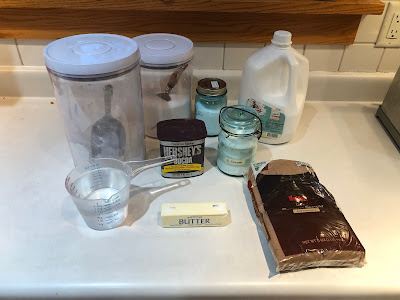The icicles are growing.
The Christmas tree is taken down.
The days are getting longer.
Georgia made us smile.
The insurrection has been turned back.
Here in snow covered Iowa, the first seeds have sprouted.
It was just another week.
Last Week in the contest
The winner in a squeaker was Banned in Boston. It was a rare win by a daylily. In second place, one vote from Banned in Boston was the annual asclepias.
Here is the full vote:
The second place finisher, the asclepias, with over 30%, is in a good position to get one of the wildcards in 7 more weeks. Spring is getting closer.
This Week- Week 7
This week is special. Every picture comes from a plant group I am currently enthusiastic about.
#1 Yellow Asiatic lily-John Hancock
June 22, 2020
It seems fitting, that in a week where patriotism was in the news, we have this picture. This is John Hancock, the Asiatic lily. It is listed as a tetraploid. That means it has extra chromosomes, perhaps artificially introduced. Ah, biology. For a plant guy I know very little biology. But at least I understand my limitations.
Lilium is the genus, in which the Asiatic lilies are found. Within that group there are also the Orientals, trumpets, martagons and all their combinations.
I have been on a lilium kick for the last 3-4 years. They do not need full sun. For that reason they can do well in the parts of the yard that get at least 4-5 hours. The even do fine right under the big old elm tree in the front yard.
If you really want to be smarter about some of that biology you can look here:
On the other hand maybe you would just be as confused as I am.
The term tetraploid appears in discussion of hosta or daylilies for example.
Mostly what I know is that a tetraploid is a plant with extra chromosomes, which usually means it is bigger and stronger.
I also understand that colchicine is a drug that can be used in monkeying with chromosomes. It comes from some fall crocus. It is also used to treat gout. This is why I stay away from biology.
#2 Pink Orchid cactus
July 8, 2020
I first met orchid cactus in a now closed nursery near the island of Chincoteague, Virginia. That was perhaps 25 years ago. We visit there every year (except 2020) as Chincoteague, where my father was born, is a wonderful place to visit. Think of these plants as Christmas cactus only much bigger. They actually are related.
I brought a plant home under my seat in the airplane. I then called the nursery and asked if they could send me more. They said they would have to charge postage. I said that was fine. I then got another half dozen. I have been growing them ever since.
I hang the plants on ropes in the trees.
They do not like a lot of direct sun.
They have to come inside for the winter. Actually they have to avoid a frost. That means they are inside from October to April.
#3 Hoya
July 1, 2020
I have so many plant enthusiasms. An enthusiasm can be thought of as a controlled obsession. But I think they are good things. I have been described as being a serial enthusiast.
There were hosta over 30 years ago. Then there were daylilies.
At the moment hoyas are on the current enthusiasm list.
This plant is Hoya Carnosa Compacta. It is called the Hindu Rope Plant. It is probably the best known of the Hoyas.
I have had this plant for 10-15 years. In 2020 it recovered from some plant abuse over the winter in wonderful fashion. Sometimes they take a long time before they bloom. This one has been blooming for over 5 years.
The blooms are in clusters. They often will set many clusters at the same time.
This plant had several flushes this year. I think of a flush as being when it blooms all over. At one point it had about 20 clusters from top to bottom.
#4 Lemon Drop Coneflower
July 4, 2020
I think I have spoken positively about all the new coneflowers that have been developed in the last 20 years. We saw this one in a garden magazine in the spring of 2019. The name was Lemon Drop. We could not find it anywhere for sale.
So last winter, about 3000 years ago, Julia found it in a catalogue that just came, unsolicited, in the mail. She ordered Lemon Drop and it did not disappoint.
It perhaps is in the category of if-you-have-to-have-only-one of a particular variety..
I do wish I could get it a few more hours of sun. But it is fine where it is, getting 4-5 hours of morning sun and dappled shade for the rest of the day.
Who knows, maybe I will get another one.
Actually a catalogue arrived this weekend that had 36 different varieties of coneflowers. With all those choices it did not have Lemon Drop. It did have Supreme Cantaloupe and Tomato Soup. That Cantaloupe looked mighty nice.
#5 Fall crocus group
September 5, 2020
I have grown these fall crocuses for probably 15 years. It is long enough that I have moved some and divided the other clumps that grew up around that same part of the garden. They plants move rather easily. They send up foliage in the spring, die back, and then bloom without leaves in the fall. I have successfully moved them in the summer.
One of the great things about fall crocuses is that you can plant them in August and they will bloom that fall. None of this wait six months stuff.
This was not intentionally a black and white picture. It is just that the colors do not really come out some mornings.
This is the first lupine seedling, coming up about 5 day after it was planted.
The Iceland poppies have also sprouted. They are too tiny to show up in this picture.
I should plant a second tray today.
Julia's recipe
Chocolate pudding cake
Chocolate pudding cake is a cousin of lemon pudding cake, different in method but with similar results: a cake layer floating on top of a pudding-like layer. It being winter, and a difficult winter in so many ways (so far), we should eat dessert. Someone gave me a magnet that is on the refrigerator: Desserts is stressed spelled backwards. So true. This recipe, like so many unpretentious desserts, is from Betty Crocker, with slight modifications.
The ingredients: 1 cup all purpose flour; 3/4 cup white sugar; 1/4 cup plus 2 tablespoons cocoa powder; 1 cup brown sugar (this and the divided cocoa powder will be clear later on in the recipe); 2 teaspoons baking powder; 1/2 teaspoon of salt; 1/2 cup milk; 2 tablespoons butter, melted; and 1-3/4 cup of hot tap water.
I started by mixing the flour, white sugar, 2 tablespoons of cocoa powder, salt and baking powder in a big bowl.
Then I melted the butter and poured it into a small bowl. I added the milk and whisked them together.
I turned the oven on to 350 degrees and lubed up a 9" x 9" pan.
Then I poured the butter-milk mixture into the dry ingredients and whisked it all up.
I switched to a silicone spatula as the batter was thick.
I scraped the batter into the pan.
Next I turned my attention to a topping which would somehow get under the batter and turn into pudding. I don't know how. It must be science.
I mixed together the 1 cup of brown sugar and the 1/4 cup of cocoa powder, shown in the bowl.
I used a soup spoon to sprinkle the brown sugar-cocoa mix evenly over the top of the cake.
Next I ran the hot water in the kitchen sink, and when it was hot, I measured out 1-3/4 cup which I poured all over the top of the cake. Really.
I baked the cake for about 35 minutes until it was dry and a bit cracked on top.
We served it warm. Each scoop of cake came with a pudding layer on the bottom. Vanilla ice cream is optional.
Odds and Ends
Only 10 more long days. A lot can happen in 10 days.
Stay safe and continue to pray for better times.
Philip























1 comment:
On this confusing Sunday, it’s a pleasure to be distracted by coneflowers and how in the heck did someone come up with this technique for making the pudding cake.
DF
Post a Comment